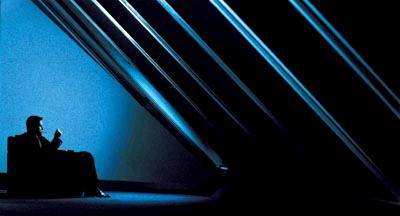

Within the first five minutes of The Bank, the formula for calculating present value appears on screen. Then, the Mandelbrot Set, one of the famous pictures from Chaos Theory shows up. Throughout the film, writer/director Robert Connolly references higher mathematics, the fall of Barings Bank, and writes on a level that would appeal to those with a rudimentary knowledge of finance. Connolly is clearly a guy of some intelligence, and puts a lot of it in his script. He hits the ground running, not caring that some of the concepts he is presenting may not be clear to some of the viewer. The Bank arrives on screen with a timely message. In today's business world, Enron and WorldCom are household names, and corporate greed and malfeasance appear nightly on the news. With all this going for it, it's a shame that Connolly, who may have a working knowledge of financial concepts, cannot craft a better script.
The Bank deals with a computer program that has the potential to predict the stock market. Jim Doyle (David Wenham, The Two Towers, The Crocodile Hunter: Collision Course) is a recent PhD graduate who studied Chaos Theory, and constructed this program. Simon O'Reilly (Anthony LaPaglia, Analyze That, The Salton Sea) works for Centabank, one of the larger banking conglomerates in Australia. He hires Doyle in the hopes that he can help Doyle perfect his program and thereby reach a sort of Holy Grail. The immediate problem is that the two have diametrically opposed philosophies. Doyle wants to predict market crashes to help people, and Doyle wants to profit monetarily. At the same time, Michelle (Sibylla Budd), an attractive co-worker, begins a relationship with Doyle. This proves a little too convenient for him, who immediately suspects darker motives of her.
The Bank shifts into high gear and its brain turns off when Doyle's program predicts a huge crash. Doyle and O'Reilly immediately clash on what to do with the information. Then, Connolly has Doyle undergo a sudden personality shift so blatantly obvious that everybody watching knows exactly what he is up to and how the plot will play itself out. There are some unknowns, but these are mostly facts necessary to tie up small loose ends. It's not fun knowing how a movie will end well before it does end. Doyle also constantly turns to a bankrupt family led by Wayne Davis (Steve Rodgers, Oscar and Lucinda), who is trying to figure out a way to get his money back. The only reason to spend so much time on Davis is to have him somehow tie into the Doyle plot, which he does. Another amusing aspect of The Bank and nearly every other movie with a computer is the fascination of filmmakers in making what appears on the computer screen look nifty instead of realistic. Doyle's program apparently crunches numbers by continually zooming in on the Mandelbrot set. Yes it looks cool, but serves no real purpose. At one point Doyle needs more computing power. Gee, if he cut back on fancy graphics, he could get a little more speed.